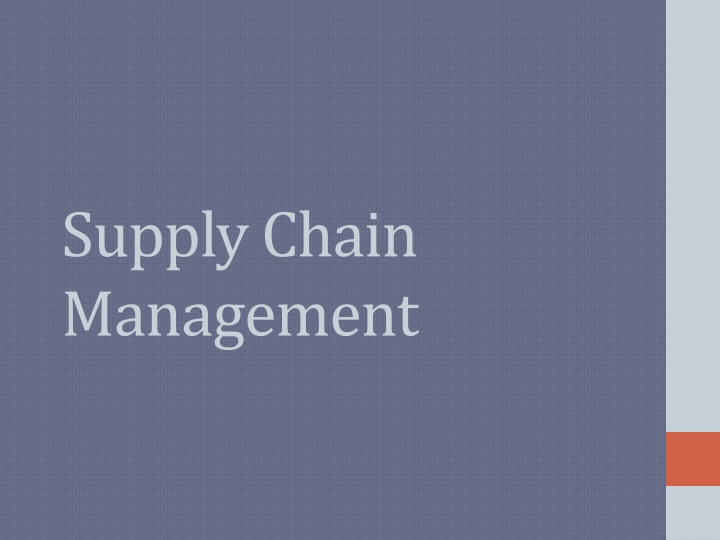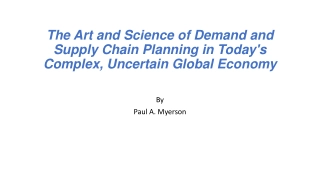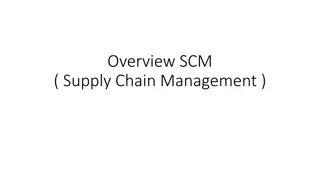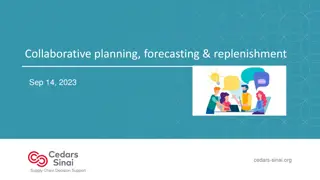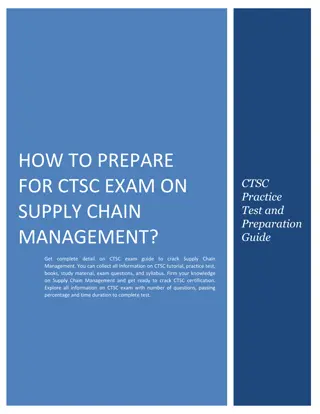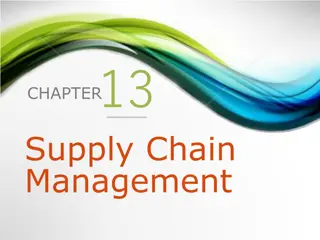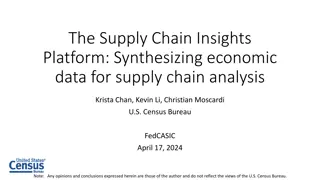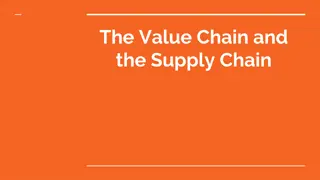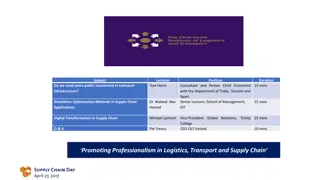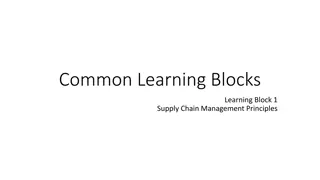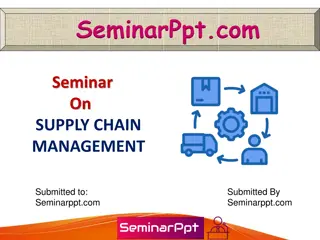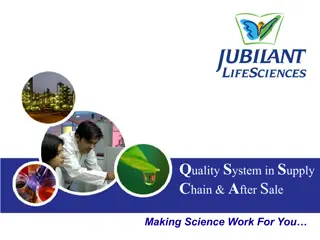Insights on Supply Chain Management
Supply chain management (SCM) involves the flow of materials, information, and finances throughout the supply chain, aiming to reduce inventory and ensure timely availability of products to meet consumer demands. Explore the significance of enterprise systems and the business value they offer in enhancing organizational efficiency and decision-making processes. Understand the interconnected network of organizations and processes in the supply chain to procure raw materials, transform them into products, and distribute them to customers efficiently. Delve into Nike's supply chain practices and the key elements of an effective SCM system.
Download Presentation

Please find below an Image/Link to download the presentation.
The content on the website is provided AS IS for your information and personal use only. It may not be sold, licensed, or shared on other websites without obtaining consent from the author.If you encounter any issues during the download, it is possible that the publisher has removed the file from their server.
You are allowed to download the files provided on this website for personal or commercial use, subject to the condition that they are used lawfully. All files are the property of their respective owners.
The content on the website is provided AS IS for your information and personal use only. It may not be sold, licensed, or shared on other websites without obtaining consent from the author.
E N D
Presentation Transcript
Supply Chain Management
Enterprise systems Sebuah organisasi yang besar terdiri dari : (e.g. E.R.P.): Rangkaian software yang terintegrasi dan central data base Mengintegrasikan informasi dari semua divisi perusahaan, departemen, proses bisnis dalam 4 area fungsional Updated information tersedia untuk semua proses bisnis Data yang sangat besar yang dapat digunakan untuk analisis manajemen
How enterprise systems should work
Business value of enterprise systems Memberikan perusahaan informasi yang luasyang dapat membantu manajer mengambil keputusan yang lebih baik termasuk menyusun formula/implementasi/evaluasi strategi perusahaan Meningkatkan evisiensi perusahaan Membantu merespong kebutuhan konsumen secara cepat Menproduksi, pengadaan dan pengiriman barang dalam jumlah banyak Menegakkan standar praktik dan data di seluruh perusahaan Membiarkan senior manajer mendapatkan informasi secara mudah untuk menentukan produk mana yang menguntungkan dan yang tidak.
What is Supply Chain Network of organizations and business processes for: Procuring raw materials Transforming them into intermediate and finished products Distributing finished products to customers Includes secondary and tertiary suppliers Upstream portion: Suppliers Downstream portion: Distributors
What is supply chain management Supply chain management (SCM) is the flow of materials, information, and finances as they move in a process from supplier to manufacturer to wholesaler to retailer to consumer. Supply chain management involves coordinating and integrating these flows both within and among companies. The ultimate goal of any effective supply chain management system is to reduce inventory (with the assumption that products are available when needed)
Components or steps of SCM Plan Source Make Deliver Return
Plan The strategic portion of SCM. Companies need a strategy for managing all the resources that go toward meeting customer demand for their product or service. A big piece of SCM planning is developing a set of metrics to monitor the supply chain so that it is efficient, costs less and delivers high quality and value to customers.
Source Companies must choose suppliers to deliver the goods and services they need to create their product. Therefore, supply chain managers must develop a set of pricing, delivery and payment processes with suppliers and create metrics for monitoring and improving the relationships. SCM managers can put together processes for managing their goods and services inventory, including receiving and verifying shipments, transferring them to the manufacturing facilities and authorizing supplier payments.
Make The manufacturing step. Supply chain managers schedule the activities necessary for production, testing, packaging and preparation for delivery. This is the most metric-intensive portion of the supply chain one where companies are able to measure quality levels, production output and worker productivity.
Deliver Also may be referred to as logistics Companies coordinate the receipt of orders from customers Develop a network of warehouses, pick carriers to get products to customers and set up an invoicing system to receive payments.
Return Supply chain planners have to create a responsive and flexible network for receiving defective and excess products back from their customers and supporting customers who have problems with delivered products..
Information and supply chain management Supply chain inefficiencies due to poor planning include: parts shortages, Can waste up to 25% of operating costs Caused by inaccurate or untimely information Uncertain product demand Late shipments from suppliers excessive inventory Safety stock: Kept as buffer for lack of flexibility in supply chain adds to costs- ideally a just in time strategy should be adopted.
Supply chain management software Used to track demand, supply, manufacturing status, logistics (i.e. where things are in the supply chain), and distribution To share data with supply chain partners at an ever increasing rate. Two main categories of software: Supply chain planning systems Supply chain execution systems
Supply chain planning systems Demand planning Order planning Scheduling and manufacturing planning Distribution planning Transportation planning
An example of Supply Chain Management Systems A decision support modelling system ; refer to lecture An important use of SmartForecasts demand planning software from Smart Software is to forecast future demand for products where demand is intermittent or irregular. Shown here is a forecast graph for the distribution of total cumulative demand for a spare part over a four-month lead time.
Supply chain execution systems Manage flow of products through distribution centres and warehouses to ensure products delivered to right locations in most efficient manner Order commitments Final production Replenishment Distribution management Reverse distribution (products/raw material that is returned)
Benefits of information sharing on the supply chain The payoff of timely and accurate supply chain information is the ability to make or ship only as much of a product as there is a market for. This is the practice known as just-in-time manufacturing, and it allows companies to reduce the amount of inventory that they keep. This can cut costs substantially, since you no longer need to pay to produce and store excess goods Requires: Retailers and manufacturers sharing information
Wal-Mart and Procter and Gamble These two companies started collaborating back in the '80s when retailers shared very little information with manufacturers. The two giants built a software system that hooked Proctor & Gamble up to Wal-Mart's distribution centres. When Proctor & Gamble's products run low at the distribution centres, the system sends an automatic alert to Proctor & Gamble to ship more products. In some cases, the system goes all the way to individual Wal- Mart stores. It lets Proctor & Gamble monitor the shelves through real-time satellite up-links that send messages to the factory whenever a Proctor & Gamble item swoops past a scanner at the Wal-Mart register.
Wal-Mart and Procter and Gamble With this kind of up-to-date information, Proctor & Gamble knows when to make, ship and display more products at the Wal-Mart stores. No need to keep products piled up in warehouses awaiting Wal-Mart's call. Invoicing and payments happen automatically too. The system saves Proctor & Gamble so much in time, reduced inventory and lower order-processing costs that it can afford to give Wal-Mart "everyday, low prices" without putting itself out of business.
Obstacles to installing and using supply chain software Gaining trust form suppliers and partners Internal resistance to change Many mistakes after implementation
Business value of supply chain management systems Matching supply to demand and reducing inventory levels Improving delivery service and speeding product time to market Using assets more effectively Increasing sales by assuring availability of products Increased profitability Supply chain costs can approach 75% of total operating budgets
Real world examples Wal-Mart http://www.cio.com/article/143451/How_Wal_Mart_Lost_Its_Techn ology_Edge Nike http://www.cio.com/article/32334/Nike_Rebounds_How_and_Why_ Nike_Recovered_from_Its_Supply_Chain_Disaster Nintendo http://www.cio.com/article/445316/Nintendo_Wii_Shortage_Shrew d_Marketing_or_Flawed_Supply_Chain_
Question Describe, the steps in implementing a, typical, supply chain. (12 marks) What are issues of the modern supply chain? marks) Explain, using a suitable example, how the use of a supply chain management system can overcome these issues. (12 marks) (6
